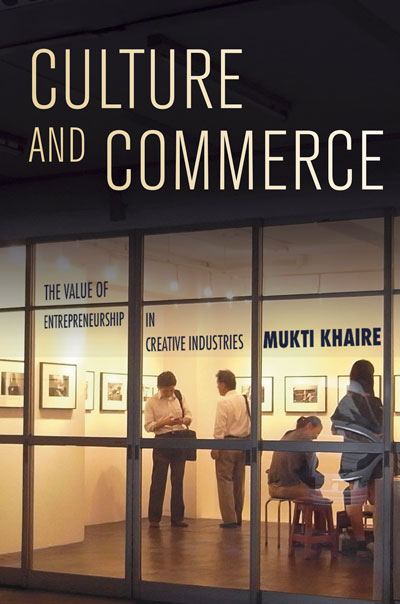Art, Culture, and Markets

Mukti Khaire’s new book, Culture and Commerce, paints a picture of value creation in the creative industries.
In her new book, Culture and Commerce: The Value of Entrepreneurship in Creative Industries, Mukti Khaire, the Girish and Jaidev Reddy Professor of Practice and director of the MBA program at Cornell Tech, demonstrates how art and the creative industries can drive broader cultural change in society. While traditional business activity can (and often does) change the way people live, Mukti Khaire argues that the ideas transmitted through art and other creative forms can change what people think when they gain a level of cultural and market acceptance.
Providing a clear framework for how commerce, commentary, culture, and consumption create value in the creative industries, Khaire casts a business eye on a process normally considered a black box, where insular communities choose winners and losers. In very clear terms, Khaire describes how a network of key players — producers, creators, and intermediaries — creates markets in the creative fields, while pioneer entrepreneurs create entirely new markets for the novel works they promote.

For example, before the Sundance Institute, a pioneer entrepreneur, began hosting its annual film festival in Utah, most Americans had little access to films beyond the dominant blockbusters of the day. By offering information and context for smaller productions, as well as a forum for their recognition, the Sundance Institute enabled more consumers to regard independent cinematic works as legitimate and interesting. Today, there is a stable market for independent cinema in the United States, along with a much warmer reception for creative forms of storytelling.
Khaire has been studying value creation in creative industries for well over a decade. She taught entrepreneurship at Harvard Business School from 2005 to 2016, where she developed an elective course, Entrepreneurial Leadership in Creative Industries, that built upon her PhD thesis, which focused on the growth of entrepreneurial advertising agencies — organizations that routinely balance creative and business imperatives.
In Culture and Commerce, which draws on this prior work, Khaire crosses artistic boundaries with ease — from the advent of hip hop to Coco Chanel’s stylistic innovations — to demonstrate how seemingly disparate cultural phenomena conform to her value-creation framework.
Compared to traditional business value, constituted mainly of material inputs, Khaire explains that the value of cultural goods is often symbolic, requiring context, explanation, and expert endorsement for market creation to occur. Enter the “pioneer entrepreneur.” Like the Sundance Institute and others, “a pioneer entrepreneur bridges the visionary world of the artist and the more mundane and pragmatic sensibilities and institutions of the market, which includes consumers who tend to seek comfort in the familiar,” writes Khaire.
Whereas pioneer entrepreneurs promote new and/or radical cultural goods, “intermediaries” play the role of evaluators and tastemakers for all goods, familiar and unfamiliar. They are the critics, the industry publications, the Michelin Guide, Robert Parker’s Wine Advocate. One outstanding example is Hollywood entertainment industry trade magazine Variety, which took 25 years to become profitable. Rather than pandering to advertisers, the magazine consistently lost lucrative advertising deals after publishing negative reviews of films. But by maintaining its objectivity, it also unlocked the key to lasting value.
Objective intermediaries are especially important today, Khaire argues, as social media has flooded the digital space with amateur commentators, making discernment between the legitimate and the half-baked much more challenging. “Intermediaries are definitely the heroes of the book,” she says, “because they have the responsibility for maintaining the balance between culture and commerce, so that it doesn’t go overboard one way or the other.”
To achieve enduring success, creative industries must maintain this delicate balance. Equipped with clear and coherent frameworks like those outlined in Culture and Commerce, more individuals and organizations will be able to create ventures in which artistic and creative genius can flourish. In the process, they stand to create lasting value for themselves, their organizations, and society at large.
